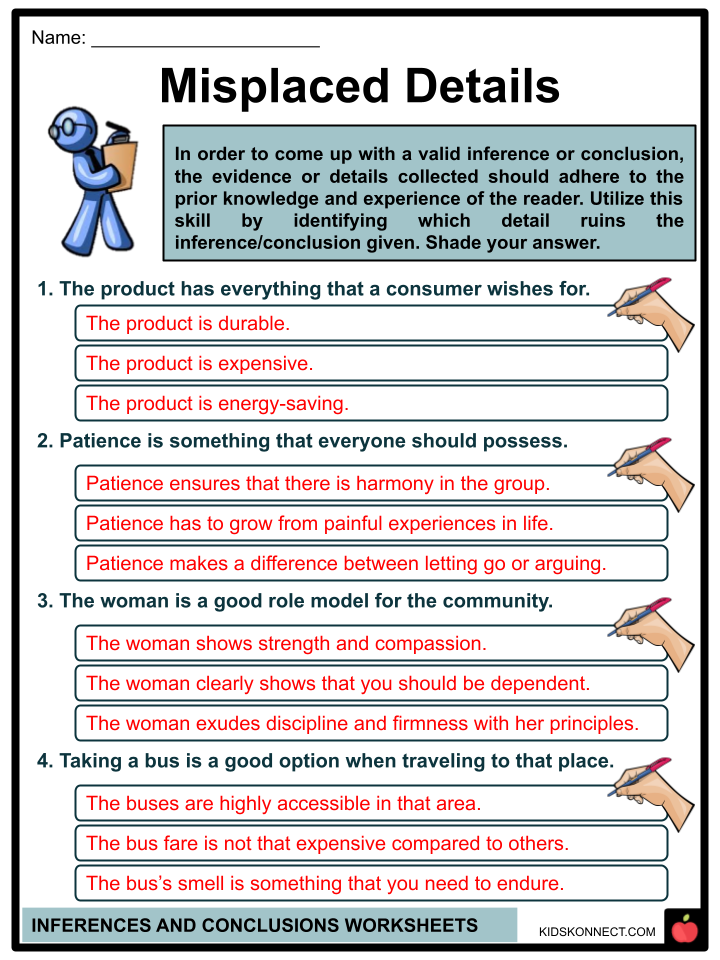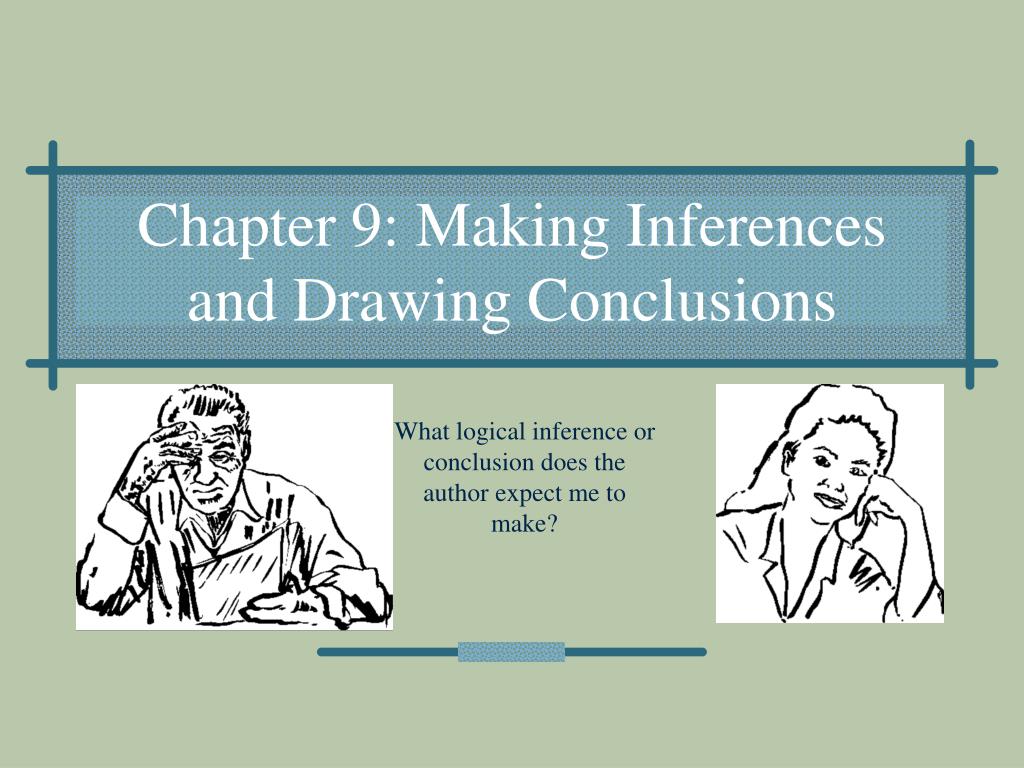Drawing Conclusions Vs Inferences
Drawing Conclusions Vs Inferences - This means that the information is never clearly stated. We make some casual observations and without definitive results and draw a general idea or statement about a person, place, thing, ideal etc. What information helps readers draw. This workforce solution was funded by a grant awarded by the u.s. Here's a brief key describing most popular methods of inference, to help you whenever you're trying to draw a conclusion for yourself.
This means that the information is never clearly stated. Web all of them have strengths and weaknesses that render them more useful in some situations than in others. Helping students understand when information is implied, or not directly stated, will improve their skill in drawing conclusions. Most definitions of inferences uses the word “clues,” but using “clues” when you are drawing con”clue”sions, made more sense to us. Making inferences is the process of figuring out missing information from information that is included. Drawing conclusions refers to information that is implied or inferred. In negotiations, the conclusions are what you come to in reaching a final settlement.
Ms. Schermerhorn's Class [licensed for use only
Students calculate margin of error and interpret it in context. A conclusion is the next logical step in the information series. A statement requires two conditions to serve as a conclusion. Web students make inferences and justify conclusions from sample surveys, experiments, and observational studies. Helping your child understand when information is implied, or not.
Inferences and Conclusions Worksheets Definition & Examples
Web all of them have strengths and weaknesses that render them more useful in some situations than in others. Web to read actively, kids need to learn to make inferences and draw conclusions about what they read. A conclusion is a decision, opinion, or judgment reached after thoughtful consideration of material you have read. An.
Making Inferences and Drawing Conclusions What's the Difference? The
Web in contrast, when we make inferences, we reach conclusions based on evidence and reasoning. Making inferences and drawing conclusions definitions an inference is a logical conclusion that is based on what an author has stated. We draw upon them by using deductive reasoning. Web students make inferences and justify conclusions from sample surveys, experiments,.
Exploring the Difference between Making Inferences and Drawing
Drawing conclusions refers to information that is implied or inferred. This means that the information is never clearly stated. Conclusions on the other hand are more definitive. Making inferences is the process of figuring out missing information from information that is included. We make some casual observations and without definitive results and draw a general.
Making Inferences and Drawing Conclusions What's the Difference? The
Both practices require a reader to make a judgment about what was read. Web observations occur when we can see something happening. Web drawing statistically valid conclusions with ml. Making inferences is the process of figuring out missing information from information that is included. Web the process of making inferences involves combining background knowledge and.
Making Inferences and Drawing Conclusions What's the Difference? The
• writers often tell you more than they say directly. Data is used from random samples to estimate a population mean or proportion. An inference is a guess a reader makes by combining personal knowledge with details from a text. Making inferences and drawing conclusions. This means that the information is never clearly stated. Web.
Drawing conclusions vs. Inferencing Drawing conclusions anchor chart
Inferences can be made with pictures, with characters, with plot, with the setting, and even with vocabulary. Let's go back to your cat and apply the process for making an inference. An inference is a guess a reader makes by combining personal knowledge with details from a text. Web to read actively, kids need to.
PPT Chapter 9 Making Inferences and Drawing Conclusions PowerPoint
Here's a brief key describing most popular methods of inference, to help you whenever you're trying to draw a conclusion for yourself. Both practices require a reader to make a judgment about what was read. Web drawing statistically valid conclusions with ml. Web there is no difference between making an inference and drawing a conclusion..
Making Inferences A.K.A….. Drawing Conclusions. What does “making an
In contrast, inferences are what we figure out based on an experience. Web 1 conclusion a conclusion comes at the end of a thought process. • writers often tell you more than they say directly. Let's go back to your cat and apply the process for making an inference. A conclusion is the next logical.
Exploring the Difference between Making Inferences and Drawing
Making inferences and drawing conclusions. Here's a brief key describing most popular methods of inference, to help you whenever you're trying to draw a conclusion for yourself. Web 1 conclusion a conclusion comes at the end of a thought process. First, it must be logically derived statement from the information given. Something that you think.
Drawing Conclusions Vs Inferences At first, you might wonder what your cat is doing. A conclusion is the next logical step in the information series. Read with purpose and meaning. Web there is no difference between making an inference and drawing a conclusion. Try one or more in your language arts classroom!
Web Mar 28, 2011.
Conclusions on the other hand are more definitive. Helping your child understand when information is implied, or not directly stated, will improve her skill in. Drawing conclusions, analyzing, and critiquing a text\'. Web making inferences and drawing conclusions • drawing conclusions refers to information that is implied or inferred.
Making Inferences Is The Process Of Figuring Out Missing Information From Information That Is Included.
Inferences also rely on facts in a situation. Instead of drawing a conclusion, inferences use facts. These inferences anchor charts will help your students get more from their reading. Web making inferences and drawing conclusions.
Web 1 Conclusion A Conclusion Comes At The End Of A Thought Process.
Let's go back to your cat and apply the process for making an inference. Making inferences and drawing conclusions definitions an inference is a logical conclusion that is based on what an author has stated. Web there is no difference between making an inference and drawing a conclusion. We draw upon them by using deductive reasoning.
Making Inferences And Drawing Conclusions.
Web to read actively, kids need to learn to make inferences and draw conclusions about what they read. Web the process of making inferences involves combining background knowledge and reasoning skills with implicit information or clues provided by the text or context to draw a conclusion that is not explicitly stated. A conclusion is the next logical step in the information series. A statement requires two conditions to serve as a conclusion.









